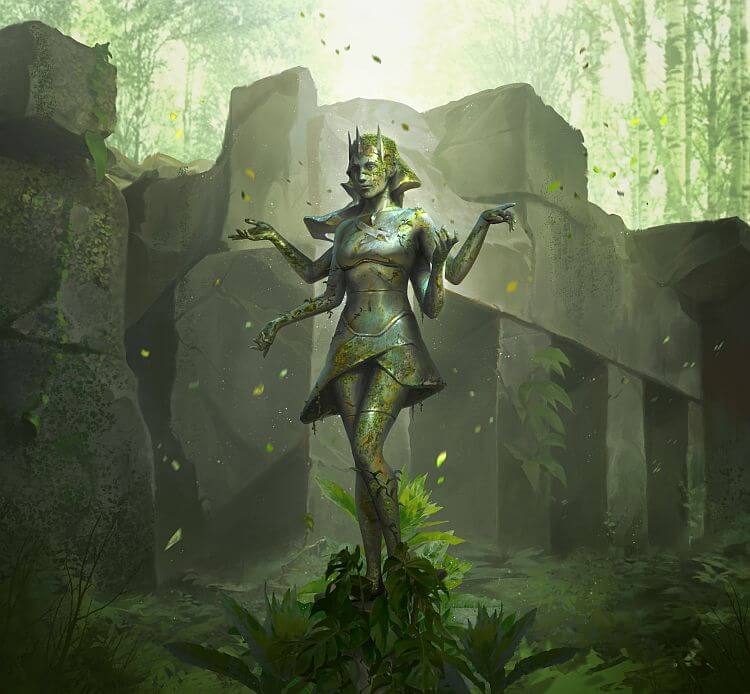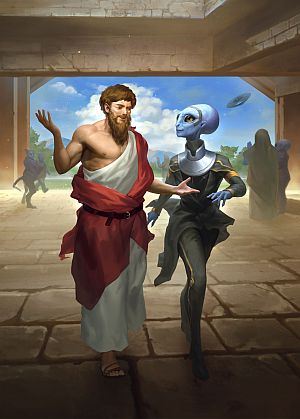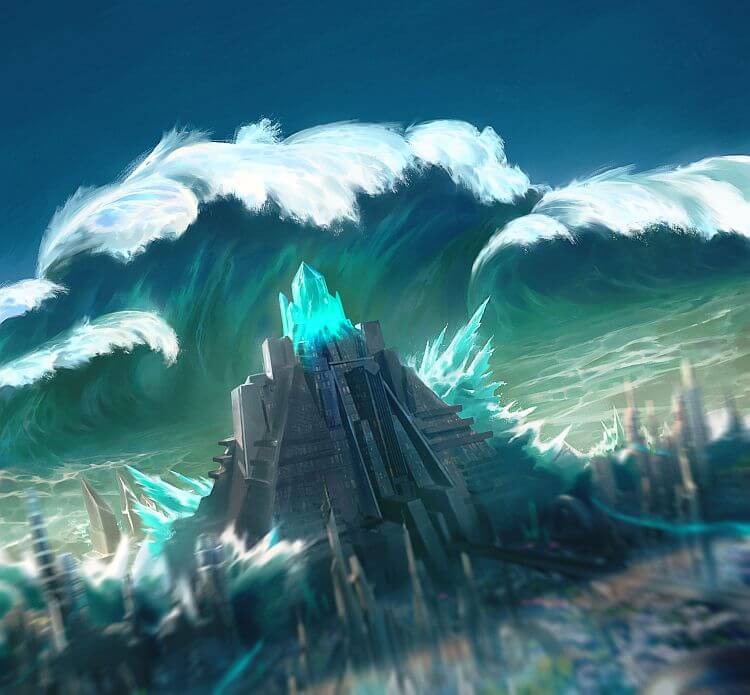Background Story
to Era of Atlantis
Table of Contents

Introduction
This story is based on the idea (which some researchers claim to have evidence for) that highly developed human civilizations existed in the prehistoric past and disappeared during the Younger Dryas cataclysm at the end of the last ice age, about 12,000 years ago. It is also part of the backstory of the predecessor game, “Galactic Era.”
Origin of Civilization

The origins of human civilization began in the distant past, nearly 100,000 years ago. During this time, the gods came down from the heavens in their fiery chariots and walked among the people of Earth. Some were benevolent and noble, while others were nefarious and deceptive. Some of these people were the giant Progenitors with their long heads, while others were of normal size but differed otherwise from humans, having strange skin colors or the heads of beasts. They were all powerful and possessed magical abilities and knowledge far beyond that of humans, and so they were worshiped by them. Many ruled as kings and queens over the human population, with reigns that often lasted for many centuries. They taught the primitive humans many technologies, such as agriculture, writing, philosophy, and architecture, but they also introduced powerful magical technologies using crystals that are now long forgotten but were widely known and used at the time. The gods and giants also had great palaces, temples, and pyramids built for them, made of enormous stones that have lasted into our times. When the gods left many millennia later, the stories of them became legends.

world map 10,000 BC
Atlantis

Atlantis was the continent of Antarctica, which was located at a higher latitude than it is now. Most of the lands were free of ice and had a temperate climate with lush fields and forests. The giant Progenitors were the rulers of these lands, and their civilization was the most advanced technologically at the time.
Their cities were great and tall, with large pyramids that produced a lot of energy. Flying craft soared through their skies, and their vessels sailed all the seas. Their most advanced vehicles could even venture into outer space. They had a worldwide impact, with colonies in all corners of the Earth, and their factories selling many goods to other civilizations.
Unfortunately, over time, the people of Atlantis became more materialistic and warlike and then succumbed to greed and the desire for power. At the end of their empire, they wanted to rule over the entire Earth. This global conflict led to their demise and the downfall of the other civilizations of the time.
Lemuria

Massive glaciers around the poles locked up a lot of water, and so many of the lands that are now submerged were once above the oceans. What are now many islands off the coast of Southeast Asia was once a great continuous landmass or subcontinent called Lemuria. Though the Lemurian civilization was much older than the Atlantean one, it was less technologically advanced than Atlantis. On the other hand, Lemuria was much more advanced spiritually.
Their priests were deeply connected to the Divine and lived by the Law of One, a philosophy about the unity of everything that had been brought to them by travelers from another star. They were respected by the other civilizations not only for their magical healing skills but also for their fairness and diplomatic prowess, which prevented many conflicts. In the end, however, all their good will and skill couldn’t save them.
Hyperborea

The Siberian reaches were also temperate lands, being further south, and were inhabited by the prosperous Hyperborean civilization. They were renowned builders, having constructed massive and towering structures that would inspire awe in observers.
Diamond City, their capital, was especially impressive, with 72 towers made of clear crystal. The walls of this city, which were equally notable, were constructed according to sacred geometry and blended in with the natural surroundings. To construct these wonders, the Hyperboreans used a secret technique of acoustic levitation, which had been passed down to them by their ancestors.
Their lands were equally beautiful, with lush vegetation and plentiful animals, which the Hyperboreans tended with great care. For a long time, these people followed the natural laws, worked joyfully, and otherwise spent much of their time with dance, song, prayer, and great feasts. It is rumored that they also lived very long lives and only died of old age when they chose to. Their way of life came to an end, though, when Hyperborea joined the great war in the final years of the era.
Brahmapura

Brahmapura was another ancient civilization that existed alongside Atlantis, Lemuria, and Hyperborea. Located in what is now India and surrounding regions, Brahmapura was known for its exotic technologies and sophisticated culture. The people of Brahmapura were highly advanced in the fields of engineering, mathematics, and astronomy, and they built great cities with advanced infrastructure and architectural wonders.
The people of Brahmapura interacted with the other major powers in various ways. They traded goods and knowledge, sharing their technological and scientific advancements. They also had diplomatic relations and often sent envoys and ambassadors to negotiate treaties and agreements. However, Brahmapura was also known for its military might, and they were not afraid to defend their interests if necessary. In times of conflict, Brahmapura often allied with Atlantis or Lemuria against common enemies, and their combined forces were formidable.
Finally, though, they developed a very powerful and destructive weapon called the Brahmastra. As a result, their leaders became arrogant, abandoning traditional friendly relations with other major powers in favor of intimidation and secrecy.
Atlantis, being the only civilization even more skilled in science and engineering than Brahmapura, eventually managed to copy the design for this weapon and build some of their own. So an arms race began between the two powerful nations, resulting in each side stockpiling an ever-greater arsenal of these highly destructive weapons.
Aztlàn

During the same time as the other great ancient civilizations, there existed yet another: Aztlàn. Located in what is now Mexico and Central America, Aztlàn was known for its highly advanced culture.
One of the things that made Aztlàn special was its unique system of governance. The people of Aztlàn believed in the power of collective wisdom, and they had a system that allowed all citizens to participate in the decision-making processes. They also valued education and knowledge highly and had a highly advanced system of education and spiritual development.
Aztlàn was also known for its sophisticated system of trade and commerce. The Aztlàns were skilled craftsmen and merchants, and they traded with many other civilizations around the world. They were particularly renowned for their jewelry, textiles, and other luxury goods, which were highly sought after by the elites of other societies.
The Aztlàns were also known for their warrior culture in addition to their advanced culture and economic success. All members of society were trained in the art of war from a young age, and they were fiercely loyal to their leaders and their country. What they lacked in technological prowess in comparison to other civilizations like Atlantis and Brahmapura, they made up for in bravery and skill. As a result, they were highly regarded by other civilizations and frequently called upon to defend their allies in times of conflict.
Downfall of Civilization
The other major powers watched with concern as tensions between Atlantis and Brahmapura grew. One day it was revealed that many of Atlantis’ elites, including the giant Progenitors, had become involved in a sinister cult. Aztlàn responded by cutting off trade with Atlantis and forming an alliance with Brahmapura. This was the final straw for Atlantis’ corrupt leaders, and war became imminent.

The Purple Dragon Society was the cult that secretly controlled the leaders of Atlantis. The cultists had become corrupted by their Great Dragon they worshiped, and as a result, had become servants of its malevolent aims. Their insane plan was to plunge the world into chaos and then rule over the ashes afterwards.
Lemuria attempted to mediate between the two sides in order to prevent the war from breaking out. However, their efforts were futile, and the two powers were soon embroiled in a fierce and brutal global conflict.

The Lemurian Brotherhood was a renowned order of peacekeepers who were often called upon to reconcile conflicting parties. However, even they were unable to prevent the great war due to the corruption and manipulation by nefarious forces among the leaders of the powerful nations.
The war lasted for many years, and the casualties on both sides were staggering. The people of Atlantis and Brahmapura suffered greatly, as their cities and infrastructure were destroyed and many of their people were killed in the fighting. The other civilizations were not spared, as they were sooner or later drawn into the conflict and suffered heavy losses as well.
The ultimate cause of the downfall of Atlantis and Brahmapura was the destructive power of the Brahmastra, a weapon that had the ability to destroy entire cities with a single strike. Both sides used these weapons recklessly in their pursuit of victory. The devastation caused by this was unprecedented. The land where each weapon had struck was poisoned for centuries to come. The entire world was plunged into darkness as the skies were filled with ash and smoke.
Pole Shift

Humanity had already fallen behind in spiritual development, but the great war and widespread use of the Brahmastra weapon exacerbated this even further, as everyone was focused on fighting or survival. So when the great solar flash, that occurs at the end of every era, struck at the peak of the war, humanity had not received the warnings and was thus unprepared. The sun was merciless and emitted a particle storm so powerful that it shifted the Earth’s axis, resulting in some continents being further away from the poles and others being closer. This pole shift also caused a massive global tsunami, which wiped out what remained of civilization and permanently raised sea levels. The continent of Atlantis froze over, covering up any trace of its civilization in a sea of ice and becoming known as Antarctica. This marked the end of the antediluvian age.
Memory of Civilization
A few survivors of the great flood tried to rebuild their societies, but they could not recover from the destruction wrought by the catastrophe. Instead, they passed on their skills and knowledge to some primitive people that had also survived in remote areas and so managed to rekindle civilization after centuries had passed.
The memory of Atlantis and the other fabulous civilizations faded into legend. These stories would be passed down through the ages, serving as a warning about the dangers of corruption and power without wisdom and the importance of living in harmony with each other.

The Order of Thoth managed to preserve some its great esoteric knowledge through the catastrophe and pass it on to the following civilizations.
This knowledge reached our times in the form of the purported teachings of Hermiticism, which state that we are in essence part of a universal, divine intelligence that permeates all of creation and that it is possible to access this intelligence through spiritual practices and disciplines.
Sources:
- books “Maps of the Ancient Sea Kings” and “The Path of the Pole” by Charles Hapgood
- book “Fingerprints of the Gods” by Graham Hancock
- TV series “Ancient Apocalypse” with Graham Hancock
- TV series “Ancient Aliens”
- book “Chariots of the Gods” by Erich von Däniken
- video “Chariots of the Gods”: https://youtu.be/HouRC6PaoR4
- http://www.unchartedx.com/
- New Discoveries That Completely Alter Human History: https://youtu.be/3qXuAzzVOTQ
- The Lost Ancient Humans of Antarctica: https://youtu.be/iBF0hP2_nGw
- The Adam and Eve Story: https://www.cia.gov/readingroom/docs/CIA-RDP79B00752A000300070001-8.pdf
- Hidden Beneath The Ice of Antarctica… Lost Civilization of the Pre-Adamites https://youtu.be/sFQMFZMBrMM
- Mahabharata, Bhagavad Gita
- The Law of One: https://www.lawofone.info/
- https://galacticera.net/background/